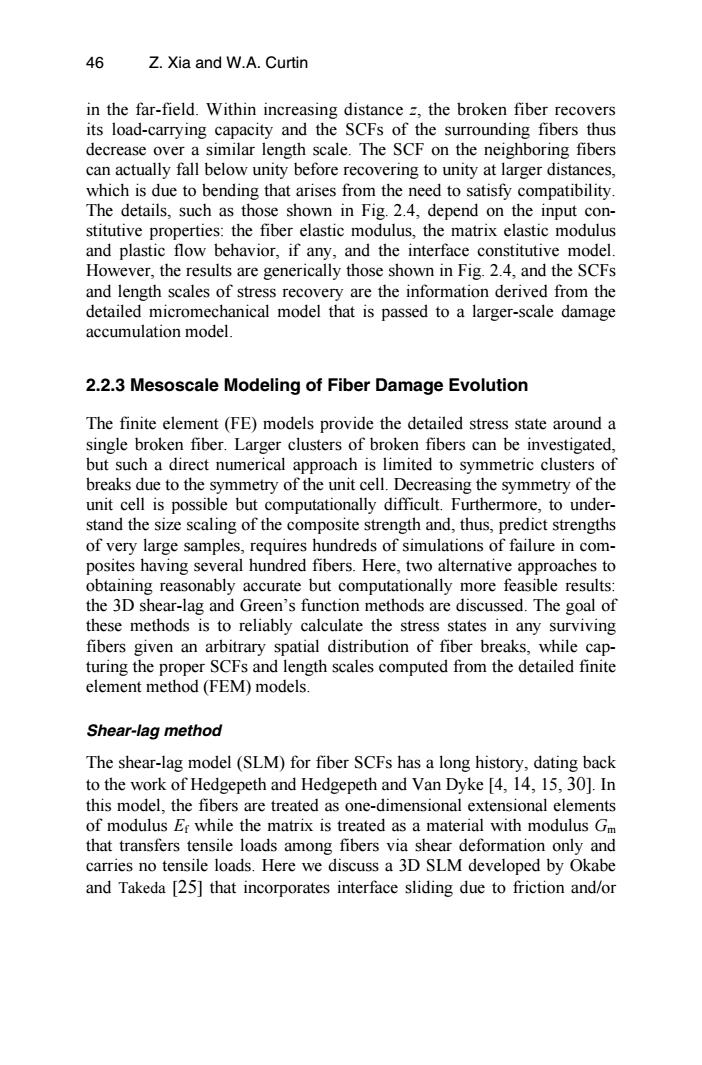正在加载图片...

46 Z.Xia and W.A.Curtin in the far-field.Within increasing distance z,the broken fiber recovers its load-carrying capacity and the SCFs of the surrounding fibers thus decrease over a similar length scale.The SCF on the neighboring fibers can actually fall below unity before recovering to unity at larger distances, which is due to bending that arises from the need to satisfy compatibility. The details,such as those shown in Fig.2.4,depend on the input con- stitutive properties:the fiber elastic modulus,the matrix elastic modulus and plastic flow behavior,if any,and the interface constitutive model. However,the results are generically those shown in Fig.2.4,and the SCFs and length scales of stress recovery are the information derived from the detailed micromechanical model that is passed to a larger-scale damage accumulation model. 2.2.3 Mesoscale Modeling of Fiber Damage Evolution The finite element(FE)models provide the detailed stress state around a single broken fiber.Larger clusters of broken fibers can be investigated, but such a direct numerical approach is limited to symmetric clusters of breaks due to the symmetry of the unit cell.Decreasing the symmetry of the unit cell is possible but computationally difficult.Furthermore,to under- stand the size scaling of the composite strength and,thus,predict strengths of very large samples,requires hundreds of simulations of failure in com- posites having several hundred fibers.Here,two alternative approaches to obtaining reasonably accurate but computationally more feasible results: the 3D shear-lag and Green's function methods are discussed.The goal of these methods is to reliably calculate the stress states in any surviving fibers given an arbitrary spatial distribution of fiber breaks,while cap- turing the proper SCFs and length scales computed from the detailed finite element method (FEM)models. Shear-lag method The shear-lag model(SLM)for fiber SCFs has a long history,dating back to the work of Hedgepeth and Hedgepeth and Van Dyke [4,14,15,30].In this model,the fibers are treated as one-dimensional extensional elements of modulus Er while the matrix is treated as a material with modulus Gm that transfers tensile loads among fibers via shear deformation only and carries no tensile loads.Here we discuss a 3D SLM developed by Okabe and Takeda [25]that incorporates interface sliding due to friction and/orin the far-field. Within increasing distance z, the broken fiber recovers its load-carrying capacity and the SCFs of the surrounding fibers thus decrease over a similar length scale. The SCF on the neighboring fibers can actually fall below unity before recovering to unity at larger distances, which is due to bending that arises from the need to satisfy compatibility. The details, such as those shown in Fig. 2.4, depend on the input constitutive properties: the fiber elastic modulus, the matrix elastic modulus and plastic flow behavior, if any, and the interface constitutive model. and length scales of stress recovery are the information derived from the detailed micromechanical model that is passed to a larger-scale damage accumulation model. 2.2.3 Mesoscale Modeling of Fiber Damage Evolution The finite element (FE) models provide the detailed stress state around a single broken fiber. Larger clusters of broken fibers can be investigated, but such a direct numerical approach is limited to symmetric clusters of breaks due to the symmetry of the unit cell. Decreasing the symmetry of the unit cell is possible but computationally difficult. Furthermore, to understand the size scaling of the composite strength and, thus, predict strengths of very large samples, requires hundreds of simulations of failure in composites having several hundred fibers. Here, two alternative approaches to the 3D shear-lag and Green’s function methods are discussed. The goal of these methods is to reliably calculate the stress states in any surviving fibers given an arbitrary spatial distribution of fiber breaks, while capturing the proper SCFs and length scales computed from the detailed finite element method (FEM) models. Shear-lag method The shear-lag model (SLM) for fiber SCFs has a long history, dating back this model, the fibers are treated as one-dimensional extensional elements of modulus Ef while the matrix is treated as a material with modulus Gm that transfers tensile loads among fibers via shear deformation only and carries no tensile loads. Here we discuss a 3D SLM developed by Okabe 46 Z. Xia and W.A. Curtin to the work of Hedgepeth and Hedgepeth and Van Dyke [4, 14, 15, 30]. In obtaining reasonably accurate but computationally more feasible results: and Takeda [25] that incorporates interface sliding due to friction and/or However, the results are generically those shown in Fig. 2.4, and the SCFs